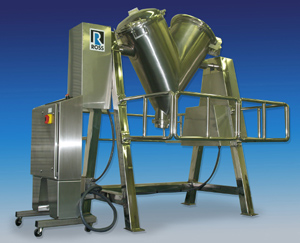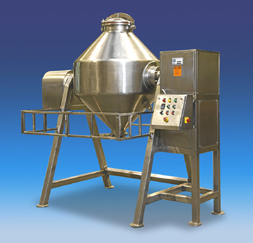Ease of cleaning
The tumble blender is easily accessible for cleaning. Smooth finishes should be specified on the wetted surfaces to improve cleanability.
Reduction of lumps
The gentle blending action of the rotating vessel alone is not suitable for breaking down tough lumps in the batch. A high speed intensifier bar is required for applications that need sufficient shear to reduce the size of agglomerates. This intensifier bar is installed along the blenderís axis of rotation.
Solid/liquid mixing
Tumble blenders can be used for mixing low-viscosity, slurry-type applications where the liquids and solids are all added through the vessel cover. If the liquid phase is a minor ingredient in the blend, it can be continuously sprayed across the solids as the blender is rotating. To accomplish this, spray nozzles are installed on the intensifier bar designed for liquid addition.
Drying
Drying applications often benefit from having a jacketed vessel that is also rated for vacuum. Vacuum drying is an excellent method for drying heat-sensitive products because it requires lower heat to drive off moisture or solvents compared to drying under atmospheric conditions. Jackets are available on both design configurations.
Controls
The most basic controls allow you to start, stop and jog the motor. However,variable frequency drives are typically recommended as they allow soft start under full load conditions. They also enable adjustment of rotational speed so that the contents can slide or cascade to the lower portion of the rotating vessel at a controlled rate. If preferred, the blender can be programmed to shut off automatically after a certain number of revolutions.
Call 1-631-234-0500 or Email to schedule a test.
Benefits of tumble blending in the food industry


